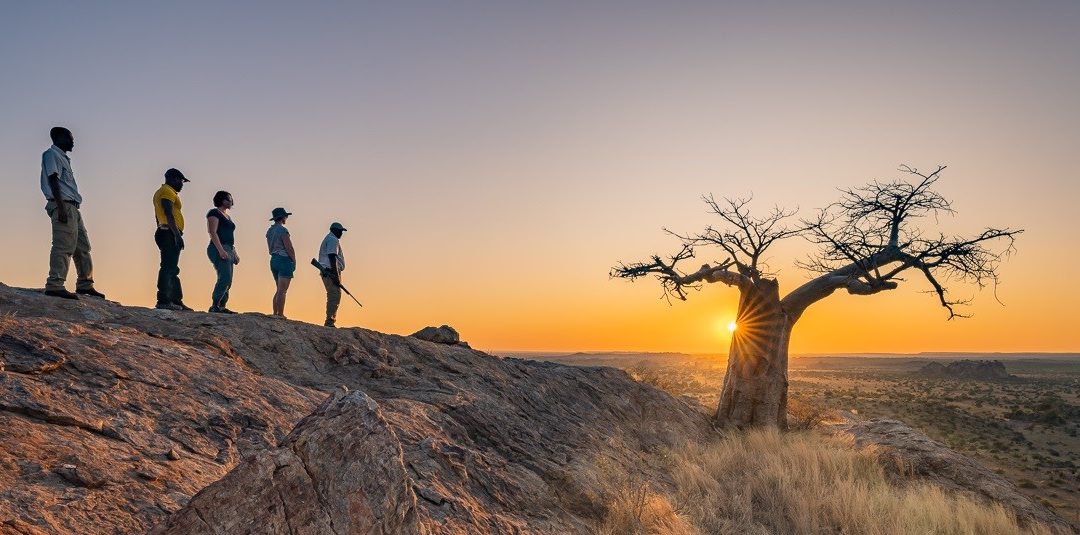On our About Us page we touched on how we got our first experience of Africa. Here is that first trip in a bit more detail.
SOUTH AFRICA
FRIDAY 12:00
On Friday lunchtime, at the end of a three-day business conference to Kwa Maritane in South Africa, Mike (our host) asked us when we planned to head home. On learning that our flight left on Sunday evening and we planned to spend the weekend exploring Johannesburg he immediately invited us (and Victor and Larry, two American colleagues) to join him on a safari – in Botswana!
Six of us then dashed north in a VW Caravelle to Pont Drift where we arrived at the Limpopo River (the border between South Africa and Botswana) at around 8pm.
SOUTH AFRICA-BOTSWANA BORDER
FRIDAY 20:00
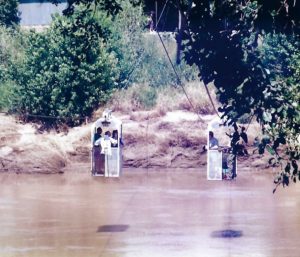 It was pitch dark, there were no lights showing anywhere and the border was closed. By some miracle, an immigration official was “found” and a single lightbulb enabled border formalities to be completed while we were being bombarded by huge dung beetles attracted by the light. This was March and the Limpopo was in flood (not that we could see). The crossing had to be completed in the dark by the cable car – a functional contraption capable of holding four people at a time and drawn across the river by a tractor engine situated on the Botswana bank.
It was pitch dark, there were no lights showing anywhere and the border was closed. By some miracle, an immigration official was “found” and a single lightbulb enabled border formalities to be completed while we were being bombarded by huge dung beetles attracted by the light. This was March and the Limpopo was in flood (not that we could see). The crossing had to be completed in the dark by the cable car – a functional contraption capable of holding four people at a time and drawn across the river by a tractor engine situated on the Botswana bank.
None of this was visible to us and it wasn’t until our return journey on Sunday that we first saw this miracle of African ingenuity and just how close we were to the rushing waters of the Limpopo as we crossed AND saw the wreckage of the old car that had been hit by a tree washed downstream.
We survived the crossing and continued our journey in the ubiquitous Toyota Landcruiser customised for safari work – i.e. with no roof or windscreen, three elevated rows of seat behind the driver and a rifle strapped to the scuttle. We now learned that our destination was the Tented Camp at Mashatu in the Tuli Block, about a 45-minute drive north from the crossing. Forty-five minutes that is, not allowing for us witnessing a leopard hunting 3 impala on the track ahead of us and illuminated dimly by our vehicle’s sidelights and the occasional peek with the spotlight. To our astonishment, the leopard made a kill right in front of our eyes.
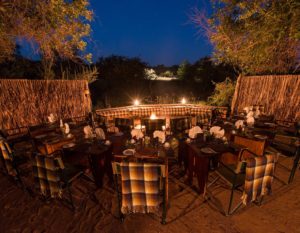 Having been brought up on David Attenborough and Big Cat Diary we thought that this sort of thing was an everyday safari experience. Now a couple of decades later we know how special these sightings are; we have the memory but no images of our first kill!
Having been brought up on David Attenborough and Big Cat Diary we thought that this sort of thing was an everyday safari experience. Now a couple of decades later we know how special these sightings are; we have the memory but no images of our first kill!
Eventually we arrived in camp, washed and quickly headed for dinner. Dinner – a three course meal with good South African wines – was served alfresco, buffet-style in the boma, comprising a semi-circle of tables around a central open hearth, surrounded by a reed fence but with a view over the bush. Oil lamps provided the only illumination and attracted all manner of night life including mantises that patrolled the table hunting moths and other flying insects. Exhausted after our journey but exhilarated by our experiences getting to camp we headed for our tents.
SATURDAY 05:30
An early greeting of “Knock, knock. Good morning” woke us and a welcome tray of hot drinks was delivered to the camp table outside our tent. Drinking hurriedly we finished dressing and headed for the mess, checking the pre-dawn shadows for whatever might be lurking as we went. Collecting rusks from the jar in the mess we climbed aboard the Toyota 4×4 from the night before and headed out with our guide Dikgang and tracker, Mfale, eager for our “first” game drive. Larry felt unwell and we left him in camp.
As a South African, Mike was well experienced in all things safari. He gave us some useful advice that we’ve held dear for the last couple of decades: “The wilderness is not a zoo or Disneyland. It’s home to the myriad of birds, insects and bigger creatures that we were here to “find;” and finding them is half the pleasure.” Mike related that when on safari he set his family a challenge – to spot 25 bird species in the first hour of a game drive. So we did some bird spotting as we drove and were amazed at the different bird species we observed. We also had sightings of that most beautiful and often underrated antelope, the impala.
SATURDAY 09:00
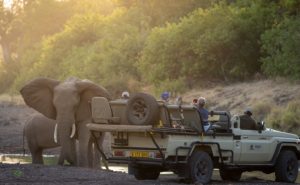
Mashatu Game Reserve. Botswana
The sun was now well up and the day warming. We stopped on a small kopje to scan the bush. From our left a small family of elephants emerged from the bush heading towards the Limpopo. Another herd soon followed the first, then another and another. At our guide’s suggestion we moved to the other side of the track and parked on another kopje for a coffee break. More and more family herds appeared – some smaller and some larger. While we were stopped we counted 300 elephants – all heading for the river – and decided to follow. Before long elephants surrounded our vehicle – teenagers delinquently trumpeting in mock bravado at our presence, babies being steered protectively between forests of legs and the adults keeping a watchful eye as we slowly and cautiously progressed through this vast herd. We learned that this 300 strong herd was part of the once much larger herd that historically migrated along the Limpopo valley, now proposed as the Greater Mapungubwe Transfrontier Conservation Area.
SATURDAY 10:30
Back in camp for an eagerly awaited and excellent brunch. Larry joined us and we recounted our morning’s experiences. Larry was impressed but had a tale of his own: while recovering in bed he had heard a sound and opened one eye to watch a snake (variety unknown) slither from one end of his tent to the other before finally disappearing under the tent flaps!
SATURDAY 16:30
Siestas over we all met for tea and cake before setting out on an evening game drive and, after sundowner drinks lit by a glorious sunset, ended up tracking a leopard that had made a kill. Mashatu it seemed was leopard city!
SATURDAY 20:00
Back in camp for another excellent meal that made us wonder how the kitchen staff achieved this with only basic equipment in what was essentially the middle of nowhere, we exchanged stories of our day before retiring.
SUNDAY 06:00
Game drive, Eat, Sleep, Repeat….
Mashatu Landcruisers have a useful addition – the radio antenna is fixed centrally at the front of the vehicle – which is ideal for breaking the anchoring strands of the Banded-legged Golden Orb-web Spider that spanned the tracks!
Mashatu is known as “The Land of the Giants” – not only for its elephants. Its lions are big and so too are the baobab trees that dot the landscape over which our human ancestors walked 200,000 years ago.
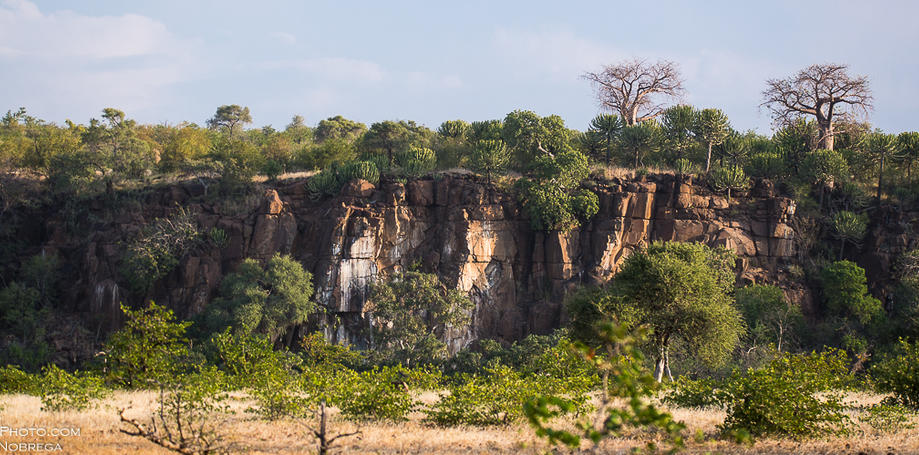
Mashatu takes its name from the tree of the same name, also known as the Nyala berry tree (Xanthrocercis zambesiaca). Mashatu is also in the Mopane [tree] veld and in certain areas elephants stunt them by continually browsing these trees so maintaining an “elephants’ garden.” As we drove through the elephants’ garden we were treated to the sight of thousands of Monotonous Larks (Mirafra passerine) each perched on a truncated Mopane and singing. They sing the same few notes day and night! Hence the name!
SUNDAY 10:30
Back in camp for brunch. Then we pack and retrace our steps – in awe of the cable car again – making the long drive back to JNB and our flight.
SUMMARY
Mashatu is a fabulous destination with stunning scenery, habituated wildlife and a hide that enables keen amateur and professional photographers to take astounding images. We have safaried there several times and introduced clients and friends to this spectacular destination.

